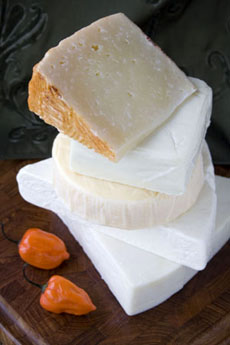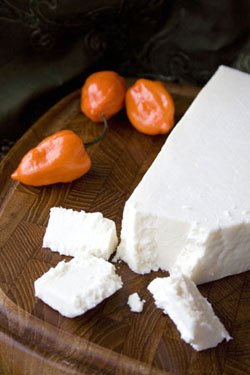

From top: Roth Käse GranQueso, Queso Blanco and Queso Quesadilla from El Viajero, Roth Käse Cotija and El Viajero Cotija. Photography by Claire Freierman | THE NIBBLE.
|
STEPHANIE ZONIS, Contributing Editor, focuses on good foods and the people who produce them.
|
|
March 2008
|
 |
Hispanic Cheese
Page 3: Aged Cheeses
- Click here to read other months’ Whey To Go columns
This is Page 3 of a five-page article. Click on the black links below to visit other pages.
This final category of Hispanic cheeses consists of aged or hard cheeses. These have a stronger flavor and a more crumbly texture than the fresh or the melting cheeses, as you might guess. Within this category, there’s a subcategory of cheeses called “añejo,” meaning “old.” However, this does not refer to a lengthy aging period. Instead, while these cheeses have been aged for some time, their dry texture and piquant, sharper taste are the result of the cheeses being salted, pressed, and dried.
These cheeses used to be made by salting fresh cheeses and leaving them outdoors to age in the heat—for up to a year! Nowadays, there are production methods that are considered much safer and more reliable.
Readily available aged Hispanic cheeses include:
- Cotija (coe-TEE-ha). Cotija is a very salty and pungent cheese, white in color and much like a dry version of feta or a younger Parmesan. Its texture can range from semi-firm to very firm, depending upon the manufacturer, but the cheese is always crumbly. It’s crumbled and used as seasoning, to top off soups, salads and bean dishes. Try grating it over corn on the cob (or corn kernels).
- There’s also Cotija Añejo (coe-TEE-ha on-YAY-hoe) sometimes called Queso Añejo, “aged cheese,” or simply Añejo, “aged”). Cotija Añejo is a mainstay of Mexican dishes. Sometimes called “the Parmesan of Mexico,” it’s of a drier, harder texture, with a salty flavor, and will typically be grated or crumbled over salads or cooked foods. (Learn more about Parmigiano-Reggiano).
- Queso Enchilado (KAY-so en-chee-LAH-doe) a.k.a. Enchilado Añejo). This is one of the few Hispanic cheeses that has a spicy element. While not as strong in taste as Cotija Añejo, Queso Enchilado is a firm, pressed cheese with a reddish appearance due to an exterior coating of either paprika or red chile. It has a salty taste, with a dry/hard/crumbly texture and is best grated or crumbled over or into soups and other cooked foods. Like fresh Hispanic cheeses, Queso Enchilado softens when heated, but it does not melt.
- Finally there is Duroblando (dew-row-BLAHN-doe) also called Queso Duro or just Duro). It is salty, strongly-flavored, again with a firm texture, and with the addition of a mild smoky taste. Found throughout the Caribbean, this cheese crumbles easily and in used for quesadillas and as a topping for bean dishes.
|

Cotija cheese from El Viajero. |
Continue to Page 4: Cheese Of The Month ~ Roth Käse’s GranQueso
Go To The Article Index Above
Lifestyle Direct, Inc. All rights reserved. Images are the copyright of their respective owners.

|





